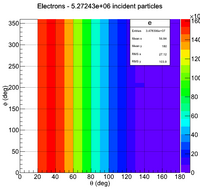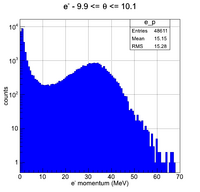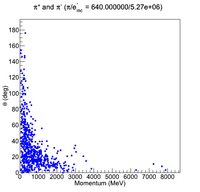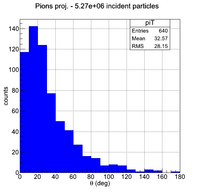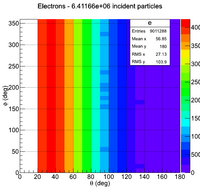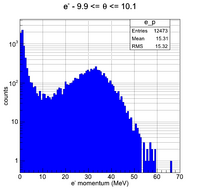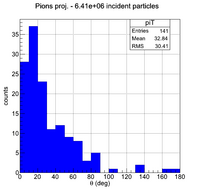Difference between revisions of "MainPage:Nuclear:DIRC"
Jump to navigation
Jump to search
| Line 33: | Line 33: | ||
! "background:#f5f5f5;" style="width: 22.5%;" | All electrons | ! "background:#f5f5f5;" style="width: 22.5%;" | All electrons | ||
! "background:#f5f5f5;" style="width: 22.5%;" | Electrons in theta = \[9.9, 10.1\] | ! "background:#f5f5f5;" style="width: 22.5%;" | Electrons in theta = \[9.9, 10.1\] | ||
| − | ! "background:#f5f5f5;" style="width: 22.5%;" | | + | ! "background:#f5f5f5;" style="width: 22.5%;" | Produced pi+ and pi- |
| − | ! "background:#f5f5f5;" style="width: 22.5%;" | | + | ! "background:#f5f5f5;" style="width: 22.5%;" | Produced pi+ and pi- |
|- | |- | ||
| '''s = 11 GeV'''<br>(e @ 60 GeV<br>p @ 0 GeV) | | '''s = 11 GeV'''<br>(e @ 60 GeV<br>p @ 0 GeV) | ||
Revision as of 17:50, 22 August 2012
| Page under construction |
| ⇐ Back to the Main_Page |
Project proposal
DIRC detector for PID at an EIC
Background simulation
We are currently running simulations on GEMC, a JLab framework based on GEANT4, to analyze the pion production in the EIC detector. It is an important analysis for the design of the detector in the sense of background particles.
The first analysis is being performed using GEMC with static target and an electron beam with equivalent energy to simulate the some energies of the collider. As a "detector", we created a sphere around the target that saves all the particles that hit it.
The parameters of the simulation are:
- Mono-energetic and pontual (not spread in transverse direction) electron beam.
- Target of liquid hydrogen with thickness of 6 cm (cylinder with radius of 1 mm)
- Detector 90 cm apart of the center of the target (particles decay may occur)
Results of the simulation
| Energy | All electrons | Electrons in theta = \[9.9, 10.1\] | Produced pi+ and pi- | Produced pi+ and pi- |
|---|---|---|---|---|
| s = 11 GeV (e @ 60 GeV p @ 0 GeV) |
||||
| s = 30 GeV (e @ 480 GeV p @ 0 GeV) |
Questions being studies now
- What are the physical processes included in GEMC?
